TASCAM US-144 USB Audio Interface
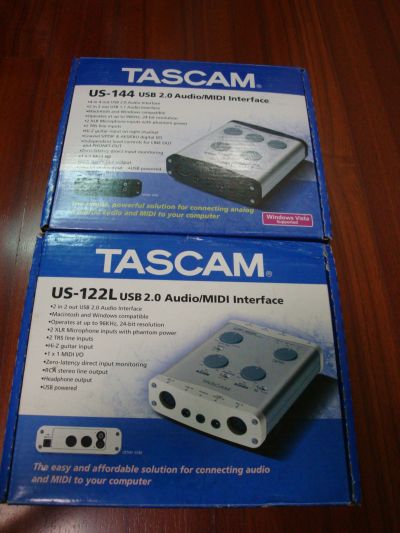
US-144 features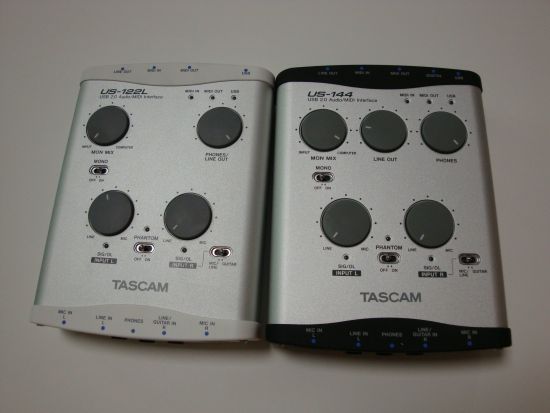
2 XLR microphone inputs with phantom power;
S / PDIF digital input and output;
2 analog line inputs (of which one can be switched to high impedance form, for guitar, bass, etc.);
1 MIDI input, one MIDI output;
Support USB 2.0 (also supports USB 1.1);
High quality 24bit/96kHz Specifications Recording;
Zero latency hardware monitoring;
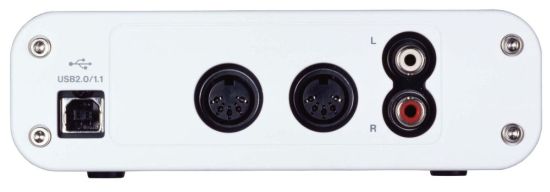
Separate headphone output with level control;
Bus-powered, compatible with PC and MAC, including laptops
Recently received a product US-122L and US-144 from CD 安奥德 distributor of USB 2.0 audio interface (Figure 1,2,3). Although I have almost fatigued USB audio interface, but they both still mention my interest, do not forget that they are Tascam production, and they have a Tascam GigaStudio and GVI, which means that US-122L and US-144 to become a few support GSIF 2 USB audio interface-driven, almost certainly is that they must be the best move using GigaStudio USB audio interface.
Figure 1: US-122L and US-144 package
Figure 3: US-122L and US-144
US-122L and US-144 Contrast:
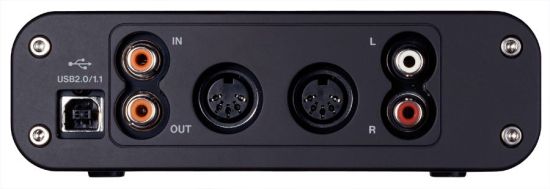
Basically US-122L and US-144 is exactly the same, the only difference is that more US-144 coaxial SPDIF input / output, which is the origin of their name. US-122L is a two into two, US-144 is a four into four. Another US-144 headphone and main outputs are different channels, there are two knobs to adjust the volume, respectively. The US-122L headphone and main outputs walk a channel, you have only one volume knob to make them consistent.
Q: Why US-122L with an L it?
A: Because the Tascam been out a long time ago called US-122 audio interface of the ......
Q: What two into two and four into four Why not call US-22L and US-44 too?
A: The Japanese way of thinking is with jumping, such as 16 into four audio interface called them to the US-1641, that is to engage into 41 ...... 16
Yimaoquren:
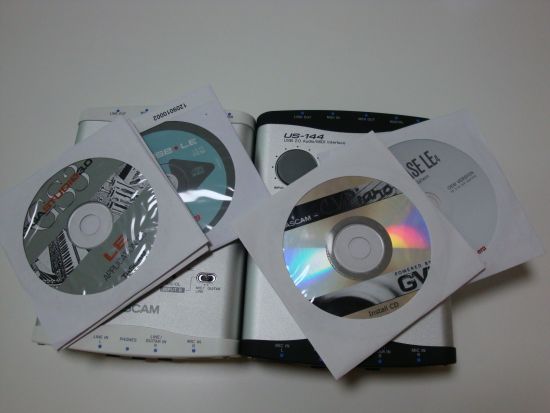
Figure 4: US-122L front, click to enlarge
Figure 5: US-144 front, click to enlarge
US-122L and US-144 (Figure 4,5) has two XLR inputs and two TRS balanced TRS elements such as interfaces, the former can connect a microphone and provide phantom power, which can be connected to the line input or switched to high impedance input connectors guitar or bass. But do not think they are four analog inputs, XLR and TRS connectors can only choose one to use, that is either connected to two microphones, a guitar or even a synthesizer, a microphone or a guitar, but can not Let the two microphone inputs plus a guitar sounds come together because US-122L and US-144 are only two analog input channels.
Two analog input channels with separate knobs to control the gain, and has an LED indicator. The lamp comes in three colors: green indicates normal signal level to enter, yellow means it explode worse 2dB, and red alerts you only 1dB on overload, and the sound has been on the verge of exploding friends.
Figure 6: US-122L behind, click to enlarge
Figure 7: US-144 back, click to enlarge
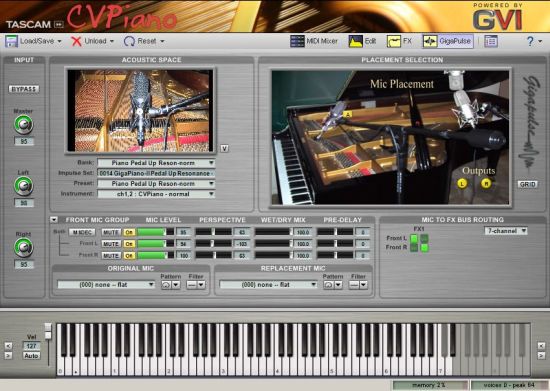
US-122L and US-144 analog output channels, only two, and for the RCA Lotus interfaces, people disappointed, as 6,7. US-144 US-122L stronger than its headphone output channels with analog output channels although the main source of the sound output the same, but can independently adjust the volume (each with two volume knobs), so you can control the singer of the actual situation ( headset) and you (monitor speakers) volume. US-122L and the main output volume on the headset can not be individually adjusted (only one volume knob controls both the main output and headphone volume).
But US-122L and US-144's main output is a very clever design: MONI switch control output sound is stereo or mono. Of course we would normally choose stereo, but if you connect a microphone and guitar while recording, you can switch to mono output MONO mix the two sounds to listen, rather than left and right channels for each listener a sound. Or when you do pickup with two microphones will come in handy.
US-122L and US-144 also has a front panel MON MIX, which is the main output voice control, mixing ratio and sound from the computer sound from the external input (microphone or guitar)'s. If you are recording with ASIO direct monitoring instead of ASIO software monitoring, that the MON MIX is obviously essential.
Finally, says US-144 multi-stereo coaxial SPDIF input / output interface than the US-122L, of course, you can also reach the highest accuracy of 24bit/96kHz.
GVI piano-based plug-CVPiano:
Figure 8: US-122L and US-144 Mini software
The official claimed that US-122L and US-144 gift all Cubase 4 and GigaStudio 3 LE, but actually not the case, as shown in Figure 8.
US-122L Lane is an old Cubase LE 1.0.10, probably because I got the US-122L or the old one batch. Official good heart provides users a free upgrade to Cubase LE 4 chance, but the deadline is May 31, 2008, you obviously missed the buy now Cubase LE 4 a.
The US-144 in though indeed presented Cubase LE 4, another disc is not GigaStudio 3 LE, but a new GVI's CVPiano piano-based plug-ins, as shown in Figure 9. But do not think they pick up a bargain, CVPiano is a free plug-in can be downloaded to the official Tascam, 156MB capacity. Tascam with a new free plug-in replaces the simplified version of an old GigaStudio, much ......
Figure 9: Based on GVI's CVPiano, click to enlarge
GVI Giga Virtual Instrument is short, which is plug-in version of GigaStudio. The CVPiano is Continuous Velocity Piano (continuous efforts piano) short, a plug housing with GVI done using GVI sampled piano engine plugin supports VSTi and RTAS formats, of course, you can also run independently CVPiano, but you may not with CVPiano to load other GVI Giga tone or timbre, because it can only playback.
Installation CVPiano very dangerous - if you are equipped with pirated Cubase SX 3 words. Since GVI need Syncrosoft dogs, so free CVPiano automatically installed when you install an analog Syncrosoft dog as genuine validation procedures, and piracy Cubase SX 3 also has an analog Syncrosoft dog program as a genuine cheating, so to solve the conflict out ...... Methods: Hypersonic SyncrosoftLicenseControlSetup.exe 2 replacement to CVPiano \ LCC \ SyncrosoftLicenseControlSetup.exe, boo ......
If you have already upgraded to Windows SP3, then also missed the GVI, CVPiano will be prompted to say that the software can only be installed on Windows SP2 or higher systems, is lower than SP2 SP3 do ......
After installation, CVPi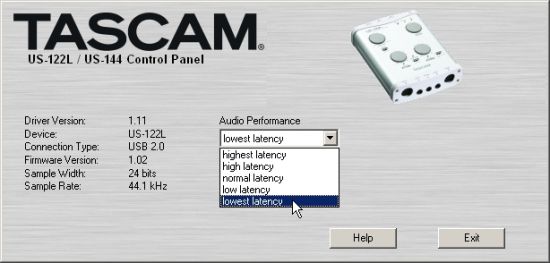 ano
ano
will not find yourself VST folder, so you can run it independently. To run it in the VST host, you need to copy CVPiano-GVI-Modeled.dll manually to the VST folder.
CVPiano installing only 400MB, but the sound is better than can be said of The Grand 2 GB on the poor, but you make sure they have a super computer, or at least a dual-core, so that when performing a simple CPU performance will reach more than 40%. If you want to run CVPiano on P4, estimated that only listen to the tone.
GSIF performance:
US-122L and US-144 supports GSIF 2 specification, which also seems to be one of the few to support GSIF a USB audio interface, you can finally move forward with the independent operation of GigaStudio (Figure 10), without having to go around a ReWire big circle.
Figure 10: US-144 running GigaStudio 3
Run the actual use of US-122L and US-144 GigaStudio 3 is very stable, if you have to work, the GigaStudio often run around looking for, then I definitely strongly recommend US series!
ASIO performance:
US series the ASIO buffer into five levels: minimum, low, normal, high and highest (Figure 11), enter the lowest buffering / output delay as shown in Figure 12. Change the general buffer after a delay in Figure 13.
Figure 11: Select the ASIO buffer size
Figure 12: Minimum latency ASIO
Figure 13: General ASIO delay
US-122L and US-144 ASIO buffer is exactly the same, no difference. But the lowest latency together almost 9ms, so I am very puzzled how a USB 2.0 audio interface but has a USB 1.1 ASIO latency in general? Obviously US series ASIO performance is not good, maybe Tascam is to optimize GSIF 2 and had to abandon ASIO?
Sound test:
24bit/48kHz using RMAA 5.5 test results (Figure 14,15,16,17), US-144 is actually slightly better (using exactly the same USB and audio cable) than the US-122L, because the family had no hex wrench is not open read, perhaps US-144 converter chip or circuit US-122L is not exactly the same.
Figure 14: US-122L Overall
Figure 15: US-144 Overall
Figure 16: US-122L frequency response
Figure 17: US-144 Frequency Response
Advantages:
24bit/96kHz USB 2.0 audio / MIDI interfaces, the use of stable
Support GSIF 2 drive, stable use GigaStudio
Metal housing, a lot of knobs and switches directly control almost all functions
Get GigaStudio LE 3 and Cubase LE 4
Our other product:








 ano
ano












